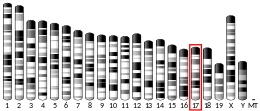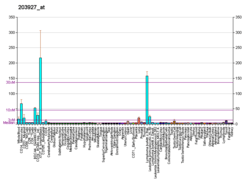NFKBIE
Nuclear factor of kappa light polypeptide gene enhancer in B-cells inhibitor, epsilon, also known as NFKBIE, is a protein which in humans is encoded by the NFKBIE gene.[5][6]
| NFKBIE | |||||||||||||||||||||||||
|---|---|---|---|---|---|---|---|---|---|---|---|---|---|---|---|---|---|---|---|---|---|---|---|---|---|
| Identifiers | |||||||||||||||||||||||||
| Aliases | NFKBIE, IKBE, NFKB inhibitor epsilon | ||||||||||||||||||||||||
| External IDs | OMIM: 604548 MGI: 1194908 HomoloGene: 36160 GeneCards: NFKBIE | ||||||||||||||||||||||||
| |||||||||||||||||||||||||
| |||||||||||||||||||||||||
| |||||||||||||||||||||||||
| |||||||||||||||||||||||||
| Orthologs | |||||||||||||||||||||||||
| Species | Human | Mouse | |||||||||||||||||||||||
| Entrez | |||||||||||||||||||||||||
| Ensembl | |||||||||||||||||||||||||
| UniProt | |||||||||||||||||||||||||
| RefSeq (mRNA) | |||||||||||||||||||||||||
| RefSeq (protein) | |||||||||||||||||||||||||
| Location (UCSC) | Chr 6: 44.26 – 44.27 Mb | Chr 17: 45.56 – 45.56 Mb | |||||||||||||||||||||||
| PubMed search | [3] | [4] | |||||||||||||||||||||||
| Wikidata | |||||||||||||||||||||||||
| |||||||||||||||||||||||||
Function
NFKBIE protein expression is up-regulated following NF-κB activation and during myelopoiesis. NFKBIE is able to inhibit NF-κB-directed transactivation via cytoplasmic retention of REL proteins.[6]
NFKB1 or NFKB2 is bound to REL, RELA, or RELB to form the NF-κB transcription factor complex. The NF-κB complex is inhibited by I-kappa-B proteins (NFKBIA or NFKBIB), which inactivate NF-kappa-B by trapping it in the cytoplasm. Phosphorylation of serine residues on the I-kappa-B proteins by kinases (IKBKA, or IKBKB) marks them for destruction via the ubiquitination pathway, thereby allowing activation of the NF-kappa-B complex. Activated NF-κB complex translocates into the nucleus and binds DNA at kappa-B-binding motifs such as 5-prime GGGRNNYYCC 3-prime or 5-prime HGGARNYYCC 3-prime (where H is A, C, or T; R is an A or G purine; and Y is a C or T pyrimidine). For some genes, activation requires NF-κB interaction with other transcription factors, such as STAT (see STAT6), AP-1 (JUN), and NFAT (see NFATC1).[5]
Interactions
NFKBIE has been shown to interact with NFKB2,[7] RELA,[7] NFKB1[7] and REL.[7][8][9]
References
- GRCh38: Ensembl release 89: ENSG00000146232 - Ensembl, May 2017
- GRCm38: Ensembl release 89: ENSMUSG00000023947 - Ensembl, May 2017
- "Human PubMed Reference:". National Center for Biotechnology Information, U.S. National Library of Medicine.
- "Mouse PubMed Reference:". National Center for Biotechnology Information, U.S. National Library of Medicine.
- "Entrez Gene: NFKBIE nuclear factor of kappa light polypeptide gene enhancer in B-cells inhibitor, epsilon".
- Whiteside ST, Epinat JC, Rice NR, Israël A (March 1997). "I kappa B epsilon, a novel member of the I kappa B family, controls RelA and cRel NF-kappa B activity". EMBO J. 16 (6): 1413–26. doi:10.1093/emboj/16.6.1413. PMC 1169738. PMID 9135156.
- Li, Z; Nabel G J (October 1997). "A new member of the I kappaB protein family, I kappaB epsilon, inhibits RelA (p65)-mediated NF-kappaB transcription". Mol. Cell. Biol. United States. 17 (10): 6184–90. doi:10.1128/mcb.17.10.6184. ISSN 0270-7306. PMC 232469. PMID 9315679.
- Kumar, S; Gélinas C (October 1993). "I kappa B alpha-mediated inhibition of v-Rel DNA binding requires direct interaction with the RXXRXRXXC Rel/kappa B DNA-binding motif". Proc. Natl. Acad. Sci. U.S.A. United States. 90 (19): 8962–6. Bibcode:1993PNAS...90.8962K. doi:10.1073/pnas.90.19.8962. ISSN 0027-8424. PMC 47481. PMID 8415639.
- Spiecker, M; Darius H; Liao J K (March 2000). "A functional role of I kappa B-epsilon in endothelial cell activation". J. Immunol. United States. 164 (6): 3316–22. doi:10.4049/jimmunol.164.6.3316. ISSN 0022-1767. PMID 10706725.
Further reading
- Hansen SK, Baeuerle PA, Blasi F (1994). "Purification, reconstitution, and I kappa B association of the c-Rel-p65 (RelA) complex, a strong activator of transcription". Mol. Cell. Biol. 14 (4): 2593–603. doi:10.1128/mcb.14.4.2593. PMC 358627. PMID 8139561.
- Kumar S, Gélinas C (1993). "I kappa B alpha-mediated inhibition of v-Rel DNA binding requires direct interaction with the RXXRXRXXC Rel/kappa B DNA-binding motif". Proc. Natl. Acad. Sci. U.S.A. 90 (19): 8962–6. Bibcode:1993PNAS...90.8962K. doi:10.1073/pnas.90.19.8962. PMC 47481. PMID 8415639.
- Whiteside ST, Epinat JC, Rice NR, Israël A (1997). "I kappa B epsilon, a novel member of the I kappa B family, controls RelA and cRel NF-kappa B activity". EMBO J. 16 (6): 1413–26. doi:10.1093/emboj/16.6.1413. PMC 1169738. PMID 9135156.
- Curristin SM, Bird KJ, Tubbs RJ, Ruddell A (1997). "VBP and RelA regulate avian leukosis virus long terminal repeat-enhanced transcription in B cells". J. Virol. 71 (8): 5972–81. doi:10.1128/JVI.71.8.5972-5981.1997. PMC 191853. PMID 9223487.
- Li Z, Nabel GJ (1997). "A new member of the I kappaB protein family, I kappaB epsilon, inhibits RelA (p65)-mediated NF-kappaB transcription". Mol. Cell. Biol. 17 (10): 6184–90. doi:10.1128/mcb.17.10.6184. PMC 232469. PMID 9315679.
- Spiecker M, Darius H, Liao JK (2000). "A functional role of I kappa B-epsilon in endothelial cell activation". J. Immunol. 164 (6): 3316–22. doi:10.4049/jimmunol.164.6.3316. PMID 10706725.
- Bourke E, Kennedy EJ, Moynagh PN (2001). "Loss of Ikappa B-beta is associated with prolonged NF-kappa B activity in human glial cells" (PDF). J. Biol. Chem. 275 (51): 39996–40002. doi:10.1074/jbc.M007693200. PMID 10998424.
- Lee SH, Hannink M (2002). "Characterization of the nuclear import and export functions of Ikappa B(epsilon)". J. Biol. Chem. 277 (26): 23358–66. doi:10.1074/jbc.M111559200. PMID 11970947.
- Bruno ME, Borchers CH, Dial JM, et al. (2002). "Effects of TCDD upon IkappaB and IKK subunits localized in microsomes by proteomics". Arch. Biochem. Biophys. 406 (2): 153–64. doi:10.1016/S0003-9861(02)00452-6. PMID 12361703.
- Strausberg RL, Feingold EA, Grouse LH, et al. (2003). "Generation and initial analysis of more than 15,000 full-length human and mouse cDNA sequences". Proc. Natl. Acad. Sci. U.S.A. 99 (26): 16899–903. Bibcode:2002PNAS...9916899M. doi:10.1073/pnas.242603899. PMC 139241. PMID 12477932.
- Emmerich F, Theurich S, Hummel M, et al. (2004). "Inactivating I kappa B epsilon mutations in Hodgkin/Reed-Sternberg cells". J. Pathol. 201 (3): 413–20. doi:10.1002/path.1454. PMID 14595753.
- Bouwmeester T, Bauch A, Ruffner H, et al. (2004). "A physical and functional map of the human TNF-alpha/NF-kappa B signal transduction pathway". Nat. Cell Biol. 6 (2): 97–105. doi:10.1038/ncb1086. PMID 14743216.
- Rual JF, Venkatesan K, Hao T, et al. (2005). "Towards a proteome-scale map of the human protein-protein interaction network". Nature. 437 (7062): 1173–8. Bibcode:2005Natur.437.1173R. doi:10.1038/nature04209. PMID 16189514.
- Nasu-Nishimura Y, Hayashi T, Ohishi T, et al. (2006). "Role of the Rho GTPase-activating protein RICS in neurite outgrowth". Genes Cells. 11 (6): 607–14. doi:10.1111/j.1365-2443.2006.00966.x. PMID 16716191.
- Stefansson B, Brautigan DL (2006). "Protein phosphatase 6 subunit with conserved Sit4-associated protein domain targets IkappaBepsilon". J. Biol. Chem. 281 (32): 22624–34. doi:10.1074/jbc.M601772200. PMID 16769727.
- Chapman SJ, Khor CC, Vannberg FO, et al. (2007). "IkappaB genetic polymorphisms and invasive pneumococcal disease". Am. J. Respir. Crit. Care Med. 176 (2): 181–7. doi:10.1164/rccm.200702-169OC. PMID 17463416.




